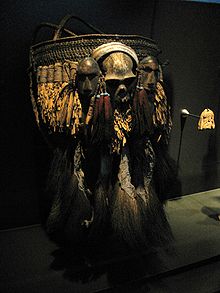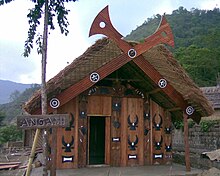Naga (people)
Naga is a collective term for over 30 ethnic groups (the Adivasi ) in the northeast of the Indian subcontinent. They are spread over the present-day states of Nagaland (since 1963), Assam , Manipur and Arunachal Pradesh . A small part also lives in the Sagaing Division in northeast Myanmar . Their total number today is estimated at 3½ – 4 million, spread over 120,000 km².
history
origin
The Naga are said to have immigrated from the east before the 12th century. Oral tradition claims that they have been resident for 52 generations. They are already mentioned in the Chronicles of the Kingdom of Manipur and the Buranjees (official historiography) of the Ahom . Despite cultural similarities, each ethnic group has its own language, institutions and traditions. Statements about “the Naga” must therefore always contain generalizations.
The Naga themselves never had a common empire of their own. Within the various groups, which are divided into clans ( khel ), society was organized from aristocratic to democratic. With the Konyak, the word of the āng is law. Before the arrival of the British (after 1826/32), the communities lived in permanent villages, mostly on mountain ridges or mountain tops, as hunters and gatherers who also carried out fire clearance. The headhunting who exercised the Naga for initiation rites and increase the prestige of the warrior, was banned by the British. The bachelors of a khel lived in shared accommodation called morungs . The marriage was exogamous .
More agriculturally advanced tribes such as the Angami, Sema and Tangkhul cultivated wet rice and were privately owned. Unlike other peoples in the region, there is a patrilineal clan system, but women had equal rights and were part of the council. Armed conflicts with the Assamese were common.
Colonial rule
The colonial rulers showed little interest in the mountainous region until plantations were established for growing tea . Because of the loss of large parts of their settlement area and the immigration of workers, clashes broke out. The British promoted the settlement of members of the Kuki and sought the support of the Meitei kings of Manipur to protect the economic interests of white settlers. 1835-1851 led several military expeditions to submission. The Naga were finally defeated after the Kohima campaign in 1879 against the rebellious Kacha Nagas .
The unhindered influx of outsiders was severely restricted by the introduction of the "inner line" in 1873. It was now necessary that every foreigner needed a special permit to enter and settle. These permits were only granted restrictively to missionaries and officials. Later, for the Naga Hills own district administration and a Naga Hills District Tribal Council established the charge of local authorities, in the villages, administered by the chief ( chief was responsible) to Naga traditions. The remote Tuensang Division and the Tirap border district remained practically without any administration. A large number of Naga came into contact with the outside world during World War I, when 4,000 of them were raised and used for British labor corps in various countries. In 1918 the Naga Club was founded as the first joint political organization. In the Government of India Act 1935 , the Naga Hills were defined as an "excluded area", where Indian laws did not apply, but continued to be administered according to local traditions. One of the early ethnological field researches in Nagaland was carried out by Christoph von Fürer-Haimendorf in 1936 .
Indian rule
Politically, the Naga organized themselves in the Naga National Council since 1946 . Imti Aliba Ao and Theyieu Sakhrie (murdered in January 1956) first reached an agreement with the governor of Assam, Sir Akbar Hydari , which secured nine-point autonomy for the Nagas, just before independence . When this was broken, an independent "Nagaland" was declared on August 14, 1947. At first there was a phase of passive resistance. From 1956 the armed struggle against the central government began. Indian security forces torched 645 of the then 851 Naga villages in 1955/56. In 1963, the Assamese district of Naga Hills and Tuensang was spun off from the North-East Frontier Agency , creating a separate state of Nagaland . With the Shillong Accord in 1975, the autonomy was further consolidated. This did not seem enough for the more radical forces who are fighting for a "Greater Nagaland" ( Nagalim ) to this day . Human rights organizations estimate that almost 100,000 Naga have been killed by Indian security forces or in intergroup fighting since 1956. Countless rape, pillage and torture are documented.
Since around 1990 the Naga have been increasingly integrated into the Indian mainstream due to the influence of modern mass media and improved transport routes. They organized their interests in various organizations such as Naga Hoho, Naga Mothers Association, Naga Students Federation (NSF), Naga People's Movement for Human Rights (NPMHR), United Committee of Manipur (UCM), All Naga Students' Association of Manipur (ANSAM) etc.
etymology
The origin of the term naga has long been debated. An older theory says that it means 'naked', according to another, a connection to the Sanskrit word nāga 'snake' is suspected. Today it is assumed that the term Naga originated from the Burmese na ka , 'pierced ear'. In fact, many Naga tribes had their ears pierced in order to decorate them with tufts of cotton during ritual dances.
religion
In the animistic Naga religion there was the concept of an overpowering creator and numerous smaller deities. The sun and moon had a religious meaning and nature was considered to be animated by invisible forces.
The Naga were Christianized mainly by American Baptist missionaries from the late 19th century . The Baptists are organized in the Nagaland Baptist Church Council . The local customs, clothing, etc. were sometimes harshly suppressed. Other Christian religious communities form small minorities. In their core region of Nagaland, the Nagas make up the vast majority of the total population of over 2 million. According to the 1991 and 2001 censuses, almost 90 percent of the population in Nagaland is Christians, around 10 percent Hindus and just under 2 percent Muslims.
Today there is a certain revival of the cultural heritage, but it has folkloric features. So today headhunting dances for tourists are performed again at the annual Hornbill Festival .
Haraka cult
The Haraka cult 1929-33 was a short-lived political-religious movement based on a mixture of animist and Hindu beliefs. He found followers especially among the Zemi, Liangmei and Rongmei. The believers were called Khampai . At that time, the rapid drop in the prices of agricultural goods caused great trouble by the Great Depression sparked by speculators on Wall Street . The World War II veteran Jadunang (from the village of Puilon) preached about a Tingwang kingdom on earth, in which there should be freedom with equal rights and duties for all. He also preached liberation from the British yoke. The teaching also penetrated to Burma, where it became the inspiration for the Saya San revolt .
After some inhabitants were killed in the plains, the British advanced with troops against the sect. Jadunang was arrested and executed in Imphal on August 29, 1931 . The movement, which now turned into a revolt, was continued by Rani Gaidinliu (born January 27, 1915) until she too was arrested in early 1933 and imprisoned for "establishing a heinous cult" and uprising in Assam (p. 18 f.). She spent almost 20 years in prison and was a freedom fighter at the head of the Zeliang People's Convention in 1991 .
Ethnic classification and distribution
Different ethnic groups dominate in the following districts:
- Kohima : Angami
- Phek : Chakhesang
- Jaluka : Zeliang
- Dimapur : (mixed district with a large proportion of Assamese)
- Wokha : Lotha (Kyong)
- Zunheboto : Sema (10% of the total Naga number)
- Mokokchung : Ao (the largest group with 11%); also Lothas and Sema
- Tuensang : Chang, Yimchungrü, Khiamniungan, Northern Sangtam
- Mon : Konyak (9%)
- Kiphire : southern Sangtam, Yimchungrü
It is partly self- and partly external names. Some groups have looked for new allies since the beginning of British colonial rule, for example the Chakhesang are a union of Chakru, Kheza, Sangtam and some Rengma. The origin of the Zeliangs also lies in the merger of Zemi , Liangmai and others. a. The significant ethnic group of the Konyak is divided into two groups, one is governed autocratically, the other governed democratically.
The habitat of the Naga is rural, but their villages can contain up to 5000 inhabitants. In earlier times they were fenced and had entrance gates. The houses, often on stilts, are built along the streets of the Ao and Lothas .
languages
The 30 or so Naga languages , with their 60 dialects, belong to the Tibetan Burman language family . As a commercial language, the Naga mostly use a pidgin language , which is based on Assamese , Bengali and Nepali and is called Nagamese in English . However, Hindi and English are often taught in schools.
literature
- JJ Roy Burman: Contours of the Naga Upsurge. Asian Economic Journal, Vol. 6 (2008), pp. 145-56
- CL Imchen: Naga myths of origin and historical reconstruction. In: M. Momin, CA Mawlong, (Ed.): Society and Economy in North-East India. Vol. 1, New Delhi 2004
- International Work Group for Indigenous Affairs (Ed.): The Naga Nation and its Struggle against Genocide. Copenhagen 1986
- Julian Jacobs: The Nagas: Society, Culture and the Colonial Encounters. London 1990
- Julian Jacobs (Ed.): The Naga. Hill Peoples of Northeast India. New York, London 2012
- Verrier Elwin: The Nagas in the Nineteenth Century. Oxford 1969
- L. Atola Changkiri: The Angami Nagas and the British 1832-1947. Guwahati 1998
- Piketo Sema: British Policy and Administration in Nagaland: 1881–1947. New Delhi 1991
- Milada Ganguli: Journey to the Naga. VEB FA Brockhaus, Leipzig 1976
- Tezenlo Thong: Progress and its impact on the Nagas. Farnham 2014
Exhibitions
- Naga. Jewelry and ashes. Textile samples, jewelery, wood carvings, Museum für Völkerkunde Vienna , February 1, 2012 to June 11, 2012.
- The oldest ethnological collection on Naga culture is in the Berlin Ethnological Museum . Until 2015, nobody in Nagaland knew about this collection.
Web links
- Official website of the Indian state of Nagaland
- Peter van Ham , Aglaja Forehead: Sounds of the Mists Beyond Time. From the Naga songbook. journal-ethnologie.de, Museum of World Cultures, Frankfurt 2008
Individual evidence
- ↑ 12–50 depending on the source; IWGIA (1986), pp. 7, 11
- ↑ Burman (2008), p. 146
- ↑ on the conflict between these peoples see: Vibha J. Patel; Naga and Kuki: Who Is to Blame? Economic and Political Weekly, Vol. 29, No. 22 (May 28, 1994), pp. 1331f
- ^ H. Srikanth, CJ Thomas: Naga Resistance Movement and the Peace Process in Northeast India. In: Peace and Democracy in South Asia. Volume 1, Issue 2, 2005
- ↑ printed in: IWGIA (1986), pp. 198-200.
- ↑ Burman (2008), p. 150.
- ↑ cf. Naga National Council and National Socialist Council of Nagaland (Isak / Muviah)
- ↑ a b International Work Group for Indigenous Affairs (Ed.); The Naga nation and its struggle against genocide. Copenhagen 1986
- ↑ ANM Irshad Ali, Indranoshee Das: Tribal Situation in North East India. (PDF; 44 kB) p. 142
- ^ Population by religious communities. Census 2001
- ↑ Archived copy ( Memento of December 30, 2008 in the Internet Archive )
- ^ Gordon P. Means: Cease-Fire Politics in Nagaland . In: Asian Survey, Vol. 11 (1971) No. 10, p. 1026
- ^ Structure of the language family: M. Paul Lewis (Ed.): Ethnologue: Languages of the World. Dallas, Tex. 2009 ( online )
- ↑ Naga - Jewelry and Ashes ( Memento from December 3, 2013 in the Internet Archive )
- ↑ Nagaland Connections - To establish a cooperation between the Ethnological Museum Berlin and members of the Naga community. In: Baessler-Archiv, Volume 65, 2018/19, pp. 197–202.


